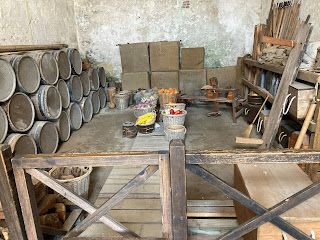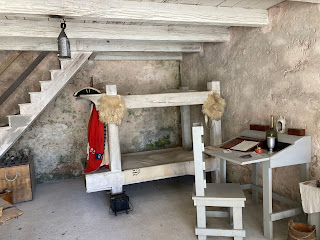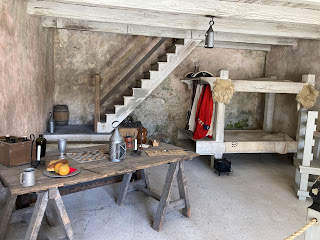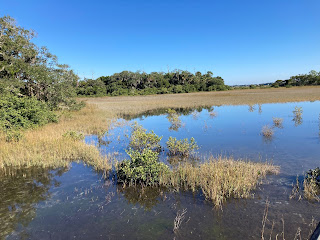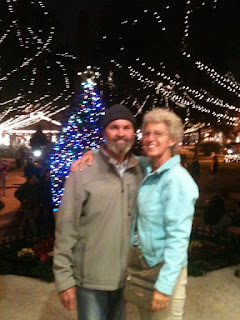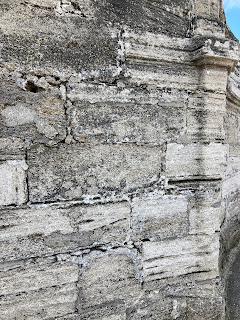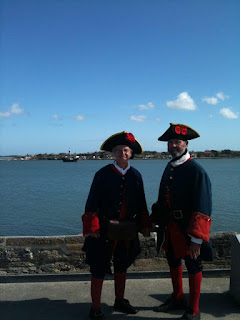 |
| "Some things are in your life for a reason, some for just a season..." |
Once we reconciled ourselves to the fact that streamlining and organizing our possessions wasn't a job that was done once and stayed done, it became, if not easy, then at least easier to begin the process of reevaluating everything that would continue to live with us. There were actually two destinations we would consider for our stuff – one for what would move back onto the boat with us, and a second for what would live in our ultimate apartment (not the one we were currently in, but hopefully years in the future when our boat life was done). Additionally we would end up doing the evaluation for what to keep twice – once when moving into the apartment, and once again when we moved back aboard; hopefully with less stuff, but with each piece being more meaningful. That was the “end” we had in mind. We were going to touch and think about every single item, many of them more than once.
We had learned a lot about downsizing when we first moved aboard from the house in Michigan to the boat (can it really have been 20 years ago?) and had to choose perhaps a tenth of everything we owned to bring with us – and still ended up with too much! Further complicating the thought process back then, it was an era when the opportunities for digital books, music, and photos was still quite limited and labor-intensive to create where it was possible at all. The strategies and insights and approaches we used then worked even better this time around. Two major insights helped us frame things in our minds, and three strategies got it done.
Major insight 1: Have a “litmus test” or “guiding principle” – a question, or series of questions, that would have yes/no answers to make the process of deciding automatic. Our guiding principle would be a blend of William Morris' classic advice “Have nothing in your home that you do not know to be useful or believe to be beautiful” (and my own addition, “or that makes you smile”) and cruising mentor Linda's advice to prioritize “first safety, then tools, then everything else” when packing. Almost 20 years aboard, plus the uncertainties of pandemic-era supply chain interruptions, had us with too much of some things, and not enough of others.
I've heard lots of other litmus-test questions: the trendy “Does this spark joy?” question never sparked joy for me. “Would you save this if there were a fire and you had just a few minutes to get out?” reminded me of a friend who lived in California; during wildfire season, he packed his priority possessions, vital documents, medications, hard drive, and dog in the car every time he let home for an errand in case his home was engulfed. “Would you buy this again if you saw it in the store right now?” didn't resonate for me; most of the things I value most have value not because of their worth, but their memories. “Would you pack this if you were moving overseas?” had me thinking of M's move from the sunny Caribbean to chilly gray northern Europe. I channeled our several hurricane evacuations and started thinking, category by category. Basically everything had to be useful, or beautiful, or make me smile. Then I refined it again – is this the best version of the thing? Is it possible to have something else do the same job as this thing just as easily and well? Would it be better to get rid of this particular thing and treat ourselves to an upgraded version of the thing?
Major insight 2: Deciding what you want to keep is a very different mindset than deciding what you want to get rid of. We couldn't just subtract out the clutter and assume that everything that remained would magically work out. We'd very likely end up with a random jumble, too much of one thing and too little of another. (This was most apparent in clothing – just subtracting the pieces I didn't like, I'd still end up with too many shirts and too few pants, too many dressy clothes and too few casual clothes, and those that remained didn't necessarily match or work well together, or cover the range of activities in our lives.) Instead, the only thing that worked for us when we did the initial downsizing to move aboard, and then again this winter, was to start with a blank slate, and only add to it what we knew we needed/wanted, by “shopping” our own possessions. It was also much easier when we decoupled the two questions “Do I want to keep this?” from “What's the best/most lucrative/environmentally friendly/charitable way to get rid of the things we no longer want?” No guilt – “Like leaves on trees in autumn,” I reminded myself. Similar to the work clothing that I donated when I retired, some things were helpful in my life for a season, but now it's time to let them gently fall away.
We promised ourselves that we wouldn't get rid of anything that made us resent the entire process. Most especially artwork, souvenirs of our travels, and other memorabilia, might not all fit on the boat, but we didn't want them permanently gone from our lives. Pirate garb and swords, collections, heirlooms, out-of-print books … anything that couldn't be replaced simply with cash by buying it again when our boat days were done, would go into the rented storage unit.
So, knowing we wanted to end up with intentional things only, we started by category, and had a few fun strategies for each.
The auto-fill strategy:
For the kitchen, we modified a trick Dan had used to advise his clients when we had the design-remodel business. “Empty the cabinets completely and put everything – Every. Single. Thing – in the basement,” he'd advise. “Now, go live your ordinary life. When you need something, a pot or a gadget, whatever, simply go down to the basement and get it. Use it, and when you are finished, wash it and put it away in the now-empty cabinet. Occasionally as time goes on you'll feel too “lazy” to go downstairs to get something for a specialized task, and will improvise by using something that's already in the kitchen, and that's okay. In fact it's good, as you'll realize in a minute. At the end of a month or so, you'll have a kitchen (sparsely) filled with things you actually use, and a basement full of things you really don't need.” Without a lot of introspection, this process made the sorting job pretty much do itself. The apartment didn't have a basement, but it did have an inconvenient cabinet reachable only by a stepladder, that served the same purpose in the scheme. The tupperware freezer containers made the grade. The special fluted tart pan with the removable bottom … didn't.
The shopping list strategy:
When it came to clothing, I found I wanted to be a little more analytical, and incorporate some of what I'd learned by having to live so minimally during those 4 tours of duty on the tall ships, plus elements of my experiments with capsule wardrobes in a single colorway and a foray into limiting myself to only 33 items of clothing for 3 months. “Imagine you had lost all your clothing in a fire,” I fantasized. “Now you're standing in a huge, posh department store with a generous insurance settlement check in your hand. What would your shopping list look like?” Now, write down that list, starting from scratch, and “shop” it from what you already own. If the list says you need 4 t-shirts? Pick your 4 favorites and let the rest go. Need a pair of black pants and don't own any you like? Well, get rid of the ones you don't like, and buy an upgrade to a better quality better fitting pair you do like.
In my working days, with two weeks between laundry trips, for each season my list would have included something like: 5 pants, 10 tops, 3 blazers for work days all in one coordinated colorway; 1 or 2 dark suits. 2 jeans, 4 t-shirts and a hoodie for weekends. 2 sparkly outfits for going on the town, 2 outfits suitable for Sunday brunch with friends and a visit to a museum, 2-3 high-tech fabric outfits for backpacking, something for a wedding, 2 or 3 things for working out, and something grungy for painting the boat, plus 5 things that aren't strictly necessary but are just plain fun. I have an oversize rainbow sweater that fits this category, and a bright-orange Hawaiian shirt. In simpler retired pandemic times, and with a washing machine right in the apartment kitchen, I ended up with 4 t-shirts, 2 jeans, 2 chinos, 2 nice pants, 4 nice tops, 2 hoodies, 2 sweaters, a fleece long underwear and a wool one; and the backpacking, workout, and painting clothes from before. Hiking boots, walking shoes, tennies, sandals, and one dressy flats, 8 pairs of shoes total. So easy! Everything I needed to own, would fit in two airline carry ons.
The Space-A strategy (military shorthand for “space available”):
I've seen people do this with kids who tend to be overwhelmed. They get a cool toy box and are told they can only keep what fits in the box, so choose your favorites. News flash – this same technique works for adults too!
When we lived in Colorado our bookshelves and display cabinets were just jammed with books and art objects. There was so much “everything” that you couldn't appreciate “anything” and books were stacked two layers deep. One day we took everything out and put it on the dining room table. We took turns placing things back, starting with our favorites. As soon as either of us felt a shelf was pleasant but not overly full, the space available appropriately used, they could call that shelf complete before they took their turn. The rest of the things had to go away, to be given away, or kept in storage to be rotated in and out museum style. We felt quite accomplished – until, when we put the house on the market, friend J. staged the house and subtracted half of even what was left!
Most art objects, if they were going to stay in our lives at all, were going to stay on the land side. If they stayed on the boat they'd become clutter and were likely to be tossed around and broken in even moderate seas. So it became a decision process of just making sure we didn't over stuff our availabe space. (We found more things that we loved than we could comfortably display at one time, so plan to do a rotation, museum style.)
As for the books themselves, my plan had been to replace some that you read linearly (like novels) with their digital versions for space-saving purposes, and keep some of the most special ones in hardcover – reference books, coffee table books with big luscious pictures, and out-of-print classics. I had grandiose plans to unpack the dozen or so cartons of those (mostly science fiction from the 1930s-1960s) and reminisce. (Of course, I also had grandiose plans that retirement would consist of life in a little stone cottage on a bluff in New England, with long after dinner walks on crunchy leaves. A tweed jacket and a pipe may also have been involved. Yeah, none of it worked out that way.) The thing is, that many of those visions from the 1960s didn't age that well. The bolder the visions were, the more likely they were to become cringe-y as the world didn't evolve along those lines and the baked-in prejudices and assumptions of the era came glaringly to light. Instead of gentle nostalgia they were probably just going to bring me dismay. Not for nothing, I also learned that the cost of replacing some of those books would add up to more than I was willing to invest. So it was kind of back to the drawing board in that realm.
Despite the fact that it was startling to see how much stuff had been on the boat – enough to spread out into a whole apartment! – what we ended up with felt calm, orderly, spacious, intentional. Every single thing felt chosen, important, used. And putting things away was easy, no more locker-Tetris! Now to see if we could get to that level on the far greater challenge of the boat, with less space but more necessary items for tools, safety, and, you know, actual sailing.































